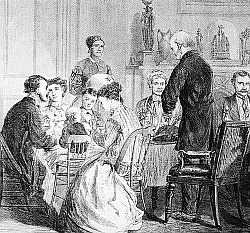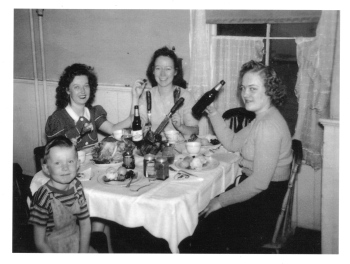Thanksgiving, Italian-American Style
Thanksgiving is the all American holiday, a feast that revolves around food, family, friends, football and more food. But I wonder what my in-laws, with their old New England traditions, would have thought of the Thanksgivings of my childhood, growing up in an Italian-American family on Long Island in the 1960s.

Our Thanksgivings were ... different. Oh yeah, we had turkey (Uncle Victor would shred it to shards with his beloved electric knife). And usually yams (with marshmallows), gravy, and some kind of stuffing thanks to Chef Boyardee and the folks at Pepperidge Farm (it was, after all, the ‘60s, that nadir of American foodways). But the centerpiece, the real piece de resistance, was my Aunt Agatha’s baked lasagna, always served proudly next to the turkey. Unlike the turkey, there were no lasagna leftovers.
My mother’s father and his four siblings were first generation Italian-Americans, born in 1890s Brooklyn. Although my Sicilian great-grandfather never learned much English, his kids all went on to college, professional careers and marriages to non-Italian spouses. My grandfather and great-uncles spoke Italian, but only as an academic exercise, practiced with flash cards for staged dinner conversations.
None of them was very interested in food, Italian or otherwise. My grandfather was particularly abstemious, with a discipline verging on monastic. Every evening he sipped a single scotch on the rocks, with an appetizer of four, never more, anchovies on four Saltines. A dinner of sliced meat, green beans and mashed potatoes followed, except for poached fish on Fridays. It never varied.

What, no #!@* lasagna?
So it fell to my Great Aunt Agatha to be the keeper of the family food flame. She was a Texan with no ties to Italy other than her marriage to Uncle Frank, but she was the one who really cared about the food. She inherited the family lasagna recipe and ran with it; she made the noodles by hand and the dish took her all day.
Aunt Agatha also made the Thanksgiving desserts--lots of them. We had the traditional pumpkin and apple pies, but she also made lemon chiffon pie, chocolate layer cakes with wild colored frostings (the Swinging ‘60s), and various cookie platters. For a few years we had multiple bundt cakes when they were all the rage, enough for everyone to take half a cake home.
Agatha was passionate about cake. Hers took on anthropomorphic characteristics. She made up names for them. When she first heard the 60s pop hit “MacArthur Park” on the car radio, she was moved to tears:
“Someone left the cake out in the rain! And he’ll never have that recipe again!” she sobbed.
“Mom! It’s not really about a cake, Mom.” consoled her daughter, with a dramatic eye roll.
“What do you mean? Didn’t you hear, ‘The sweet green icing’? Of course it’s about a cake!”
She was inconsolable.
Although our Thanksgiving was not out of Currier and Ives, I later learned that my experience was not that unique. Other Italian-American families had their own Agathas who prepared similar feasts. I would informally survey colleagues and acquaintances with Italian surnames. It was a bit like invoking the Pirate Code:
Me: “So you’re part Italian?”
Them: “Yeah, on my Mom’s side.”
Me: “Thanksgiving?”
Them: “Lasagna.”
Now Thanksgivings in my family are all about authenticity. The Pilgrims, or at least the inventors of modern Thanksgiving in the nineteenth century, might recognize the food. We have both roasted and boiled turkey, both mushroom and oyster stuffings, and we have two kinds of onions, and sprouts, and gravy as well as celery, bread and oyster sauces, mashed potatoes and turnips and more, along with plum pudding and many pies. I miss the lasagna.

